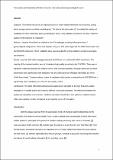Files in this item
The quality and readability of online consumer information about gynaecological cancer
Item metadata
| dc.contributor.author | Sobota, Aleksandra | |
| dc.contributor.author | Ozakinci, Gozde | |
| dc.date.accessioned | 2016-03-01T00:12:12Z | |
| dc.date.available | 2016-03-01T00:12:12Z | |
| dc.date.issued | 2015-03 | |
| dc.identifier | 156117562 | |
| dc.identifier | f00d423f-2022-498a-ba27-c95ab672e226 | |
| dc.identifier | 84924348677 | |
| dc.identifier | 000350123800028 | |
| dc.identifier.citation | Sobota , A & Ozakinci , G 2015 , ' The quality and readability of online consumer information about gynaecological cancer ' , International Journal of Gynecological Cancer , vol. 25 , no. 3 , pp. 537-541 . https://doi.org/10.1097/IGC.0000000000000362 | en |
| dc.identifier.issn | 1048-891X | |
| dc.identifier.other | ORCID: /0000-0001-5869-3274/work/27163474 | |
| dc.identifier.uri | https://hdl.handle.net/10023/8334 | |
| dc.description | Aleksandra Sobota’s PhD is funded by the Danuta Richardson Medical Scholarship. | en |
| dc.description.abstract | Objective: The Internet has become an important source of health-related information for consumers, among whom younger women constitute a notable group. The aims of this study were: (1) to evaluate the quality and readability of online information about gynaecological cancer using validated instruments; and (2) to relate the quality of information to its readability. Methods: Using the Alexa Rank we obtained a list of 35 webpages providing information about 7 gynaecological malignancies. These were assessed using the HON seal of approval, the JAMA benchmarks, and the DISCERN instrument. Flesch readability score was calculated for sections related to symptoms and signs, and treatment. Results: Less than 30% of the webpages displayed the HON seal or achieved all JAMA benchmarks. The majority of the treatment sections were of moderate to high quality according to the DISCERN. There was no significant relationship between the presence of the HON seal and readability. Webpages achieving all JAMA benchmarks were significantly more difficult to read and understand than webpages that missed any of the JAMA benchmarks. Treatment-related content of moderate to high quality as assessed by the DISCERN had a significantly better readability score than the low quality content. Conclusions: The online information about gynaecological cancer provided by the most frequently visited webpages is of variable quality and in general difficult to read and understand. The relationship between the quality and readability remains unclear. Healthcare providers should direct their patients to reliable material online since patients consider the Internet as an important source of information. | |
| dc.format.extent | 5 | |
| dc.format.extent | 130684 | |
| dc.language.iso | eng | |
| dc.relation.ispartof | International Journal of Gynecological Cancer | en |
| dc.subject | R Medicine | en |
| dc.subject | RC0254 Neoplasms. Tumors. Oncology (including Cancer) | en |
| dc.subject | NDAS | en |
| dc.subject | SDG 3 - Good Health and Well-being | en |
| dc.subject.lcc | R | en |
| dc.subject.lcc | RC0254 | en |
| dc.title | The quality and readability of online consumer information about gynaecological cancer | en |
| dc.type | Journal article | en |
| dc.contributor.institution | University of St Andrews. School of Medicine | en |
| dc.contributor.institution | University of St Andrews. St Andrews Sustainability Institute | en |
| dc.contributor.institution | University of St Andrews. Health Psychology | en |
| dc.identifier.doi | https://doi.org/10.1097/IGC.0000000000000362 | |
| dc.description.status | Peer reviewed | en |
| dc.date.embargoedUntil | 2016-03-01 |
This item appears in the following Collection(s)
Items in the St Andrews Research Repository are protected by copyright, with all rights reserved, unless otherwise indicated.

